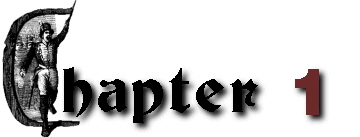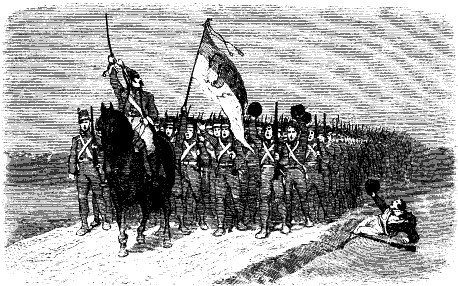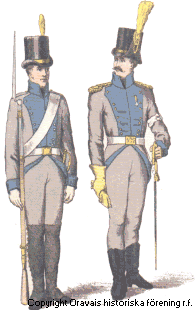
Background
By 1807 the French emperor had trampled all over Europe. His military genius had brought about the victories at Austerlitz, Jena-Auerstädt and Friedland; his eagles had been seen flying in Berlin and Vienna, the capitals of two of Europe's most powerful nations, Prussia and Austria. But while Emperor Napoleon's armies were winning victories on land, the Royal British Navy was holding up resistance against the French at sea. The legendary battle of Trafalgar in 1805 ended in a splendid victory for the, likewise, legendary British admiral Nelson, who secured British superiority at sea. The Franco-Spanish fleet was soundly beaten, and with that, all French plans for invasion in Britain were postponed.
This was where Napoleon's Continental Blockade came into the picture. After having beaten Prussia in 1806 and secured his hold on Germany, Napoleon proclaimed the Blockade in Berlin on November 21, 1806. Napoleon planned to defeat the British through economic warfare by closing all European ports for British trade. His attempts to keep the Blockade running from then on became the Emperor's main political goal, and after the decisive battle of Friedland on June 14 1807, where Napoleon had rolled up the Russian lines and thrown them back into the river Alle, the turn came for Russia to join the Continental Blockade.
The Emperor of the West, Napoleon I of France, and the Emperor of the East, Czar Alexander I of Russia, met for peace negotiations on a raft on the river Niemen on July 7, 1807. The two Emperors were very much fascinated by each other, and inspected major military reviews together, they dined together and were involved in hour-long conversations. Soon enormous plans for the future of the entire world started to take form. Europe was in theory divided between Russia and France. This turns our thoughts to the Hitler-Stalin pact of 1939-41 where a similar agreement was reached between Germany and the Soviet Union. In the secret agreement between the two Emperors in 1807, it was decided that Russia should take upon itself the task of forcing Sweden into the Continental System. As a prize for his efforts, the Czar would receive Finland, which was at the time, the eastern province of the Swedish empire.
The task at hand was very much in Alexander's taste. By beating Sweden and incorporating Finland into his massive empire, he would not only expand the Russian borders to the West and secure the position of the Russian capital of St. Petersburg, but also provide the arch-enemy Sweden with a humiliating defeat.

Gustav IV Adolf became the king of Sweden in 1796 (he ruled until 1809) as his eccentric father, "the theatre king", Gustav III had been murdered in 1792. Gustav IV Adolf was a fierce hater of the French revolution, and he had also been reading too much of the book of revelations because he saw Napoleon as the beast in that book. "Gustav IV Adolf's hate against Napoleon was deep, true, almost monumental. The king saw Napoleon as the Antichrist wandering on the face of the Earth and he was therefore not prepared to make any compromises in his war against the "French hydra". It meant to apply the weak resources of the Swedish kingdom to the gigantic powerstruggle that was occuring in Europe as a whole. The king had been reading the book of revelations in the Bible and saw Napoleon as the incarnation of evil, all according to the prophecy of the Apocalypse. Rather than to surrender for Napoleon, the king was prepared to leave the country and continue the struggle from England", Kent Zetterberg tells us in his essay in Krig kring Kvarken.
At the end of 1807 and the beginning of 1808, the Swedish government ignored all reports of the massive maneuvres at the Russian border. The Swedish ambassador in St. Petersburg sent reports home to Stockholm and expressed his concern as the Russian armies were marching up. Nothing was done on the Swedish side. Without declaring war on Sweden, Russian troops crossed the border to Finland on February 21, 1808. This sunday, the Swedish major Gustav Arnkihl, of the Nyland dragoons - who was posted at the border - signed a report to the brigade command. "...that the Russians have crossed the border at 5 o'clock today, with a considerable force... it is also reported that they have crossed at Abborfors and also that they have gone over at Korois with Cossacks and pointed their march in our direction." The union's last war had begun.
The condition of the opposing armies
The Swedish army
Unlike the Russian soldier, the Swedish soldier was a free man. The Swedish system meant that putting up troops, as well as supplying and maintaining them in peacetime, were the responsibilities of the landowners. In this manner all the land was divided into "rotar", and with each of these came one soldier for the army. The landowners supplied the soldiers with farms and a livelihood. The soldiers had families and were often unprepared to go to war. The military education of these troops were often lacks and the ties to the family and home came way before risking their lives in war. In this way the Swedish army consisted of two parts, the troops that served "part-time" and the ones that served "full-time", the men hired for the army, of which most were garrison troops.
At the outbreak of war the Swedish army in Finland could put up 17.323 men, of which about 750 were cavalry. The army was under the command of general Mauritz Klingspor (1744-1814), who was a very cautious commander, on the brink of cowardly. He never wanted to spend too much time on the battlefield and he was often seen leaving the command to other officers while he put himself in safety. Most often Karl Johan Adlercreutz (1757-1815) exercised command on the field of battle when the main army was involved in fighting. Klingspor was more a bueraucrat and a desk-warrior than a man suitable for leading an army in the field. While we will see Swedish generals like Adlercreutz, Georg Karl von Döbeln and Johan August Sandels be more than a fair match against the Russian commanders during the war, the high command of the Swedish army was most often stiff, conservative and buried in its own bueraucracy.
 The traditional uniform of the Swedish army was in blue and yellow, but during the era of Gustav IV Adolf, the army had also been experimenting with uniforms in grey. For the most part, the troops in Finland wore the grey uniform - with cuffs and stripes in varying colours for each regiment - except the Österbottens regiment that wore the yellow and blue uniform. The jaegers of Karelen had green jackets and white trousers, which made them look strikingly like the Russian infantry. The Swedish infantry wore cylindrical hats. The men wore their uniforms until they were totally worn-out, meaning that the army must have been a very confusing sight as many different types of uniforms were represented. Never has the state of the Swedish uniform been so confusing as during the war of 1808-09. To the right we see the uniform of the famous Björneborg regiment.
The traditional uniform of the Swedish army was in blue and yellow, but during the era of Gustav IV Adolf, the army had also been experimenting with uniforms in grey. For the most part, the troops in Finland wore the grey uniform - with cuffs and stripes in varying colours for each regiment - except the Österbottens regiment that wore the yellow and blue uniform. The jaegers of Karelen had green jackets and white trousers, which made them look strikingly like the Russian infantry. The Swedish infantry wore cylindrical hats. The men wore their uniforms until they were totally worn-out, meaning that the army must have been a very confusing sight as many different types of uniforms were represented. Never has the state of the Swedish uniform been so confusing as during the war of 1808-09. To the right we see the uniform of the famous Björneborg regiment.
The Russian army in 1808
Shortly before the war of 1808, the Russian army was reformed and composed in the same manner as the French army. The system with divisions was therefore in full function at the outbreak of war and the Russian army could show up 24 divisions. The Russian division was composed of six regiments infantry, of which one or two were jaeger regiments. Among these, artillery and cavalry were placed. Russian infantry regiments consisted of three batallions, with four companies each. In theory, a regiment at full strength had about 2000 troops. The Russian army was by no means unprepared for what was coming. The reforms in the army, as well as the rebuilding of units that had taken losses in the 1806-07 campaigns resulted in a war-experienced and powerful invasion force. 80.000 troops were saved for the coming campaign, of which 50.000 would have been thrown into the fighting by the end of the war.
The Russian regular grenadier troops wore tight green uniform jackets and white trousers, the jaeger troops wore entirely green uniforms. The colours on collars and shoulder pads differed from regiment to regiment. The old bicorne hats had been exchanged by shakos in 1803. The Russian cavalry was well known in all of Europe, and especially the irregular Cossack cavalry was so famous that horrible stories flew around the continent about these "barbarians". Nonetheless the free Cossack of the Russian steppes was something of a trademark for the Czar's army. Most important of these Cossack-units was the Don army, that could show 40.000 troops by the beginning of the 19th century. All in all the Russian army consisted of 400.000 troops, deployed throughout the massive empire, and if we add the number of the irregular cavalry to that, we can easily reach the double.
The Russian invasion of Finland in february 1808, was built up in the following manner. Left flank: 17th division, ca 8000 men, under lt. gen. Gortschakoff, concentrated near Fredrikshamn. Centre: 21st division, ca 8700 men, under lt. gen. Peter Ivanovitsch Bagration, concentrated on the roads east of Anjala. Right flank: 5th division, ca 7000 men, under lt. gen. Nikolai Alexejvitsch Tutschkoff, concentrated near Nyslott. The commander of the entire Russian army was Fredrik Wilhelm von Buxhoevden, total strength, 24.000 troops.
Summing up. Although the defeat in the wars against Napoleon, the Russian army was in a good condition. It was experienced and well organized. To this we can add the quality of the Russian commanders that were to take part in the coming campaign in Finland. The bad morale among the soldiers was one of the difficulties for the army though, it was said that the Russian army was built up of slaves. While the Swedish army consisted of free soldiers, the Russian men were most often serfs. The honour of being a soldier was not felt in the Russian army, as it was in the Swedish; the Swedish often saw the uniform as something honourable, an evidence of manhood. The two armies that were to meet on the field of battle were really each others opposites.
Some words about the famous commander of the Russian army, Friedrich Wilhelm von Buxhoevden (1750-1811), should be in place. Buxhoevden was born in a Livonian family and already by 1764, he joined the Russian army where he gained his first experience in the field during the Turkish wars. In 1788-90 he fought against Sweden as major general, commanding a brigade. Later, during the battle of Austerlitz in 1805 he led the allied left flank and participated in the 1806-07 campaigns in Poland and Prussia with varied success. After having commanded the armies of invasion in Finland, he was made general but was never brought back in command. He died in 1811. Buxhoevden was an experienced general.
Next chapter
Back to The Final War Chapters
© Göran Frilund 2000-03, All Rights Reserved.
If you've surfed onto this page from outside and there is no menu on the left,
CLICK HERE for the full Website.



 The traditional uniform of the Swedish army was in blue and yellow, but during the era of Gustav IV Adolf, the army had also been experimenting with uniforms in grey. For the most part, the troops in Finland wore the grey uniform - with cuffs and stripes in varying colours for each regiment - except the Österbottens regiment that wore the yellow and blue uniform. The jaegers of Karelen had green jackets and white trousers, which made them look strikingly like the Russian infantry. The Swedish infantry wore cylindrical hats. The men wore their uniforms until they were totally worn-out, meaning that the army must have been a very confusing sight as many different types of uniforms were represented. Never has the state of the Swedish uniform been so confusing as during the war of 1808-09. To the right we see the uniform of the famous Björneborg regiment.
The traditional uniform of the Swedish army was in blue and yellow, but during the era of Gustav IV Adolf, the army had also been experimenting with uniforms in grey. For the most part, the troops in Finland wore the grey uniform - with cuffs and stripes in varying colours for each regiment - except the Österbottens regiment that wore the yellow and blue uniform. The jaegers of Karelen had green jackets and white trousers, which made them look strikingly like the Russian infantry. The Swedish infantry wore cylindrical hats. The men wore their uniforms until they were totally worn-out, meaning that the army must have been a very confusing sight as many different types of uniforms were represented. Never has the state of the Swedish uniform been so confusing as during the war of 1808-09. To the right we see the uniform of the famous Björneborg regiment.